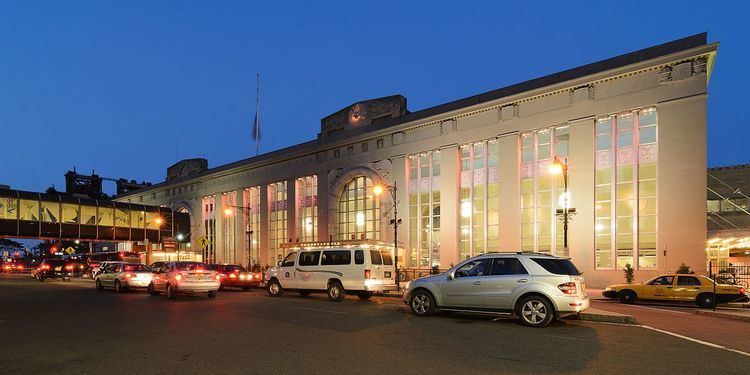Owned by New Jersey Transit Area 2 ha Tracks 8 | Opened 24 March 1935 Phone +1 800-872-7245 | |
 | ||
Location Raymond Plaza West and Market Street
Newark, NJ 07102 Line(s) Amtrak:
Acela Express
Cardinal
Carolinian
Crescent
Keystone Service
Palmetto
Pennsylvanian
Northeast Regional
Silver Star
Silver Meteor
Vermonter
NJ Transit:
Northeast Corridor Line
North Jersey Coast Line
Raritan Valley Line
Newark Light Rail:
Grove Street – Newark Penn
Broad Street – Newark Penn
PATH:
NWK–WTC Platforms 1 side platform (upper level)
3 island platforms and 2 side platforms (main level) Connections NJT Bus: 1, 5, 11, 21, 25, 28, 29, 30, 34, 39, 40, 41, 62, 67, 70, 71, 72, 73, 76, 78, 79, 95, 108, 308, 319, 361, 375, 378
ONE Bus: 31, 44
Greyhound Lines
Peter Pan Bus Lines
Susquehanna Trailways Parking Available in immediate area Address 1 Raymond Plaza W & Market Street, Newark, NJ 07102, USA Similar Metropark station, Princeton Junction station, Newark Broad Street Sta, Trenton Transit Center, Newark Liberty Internatio | ||
Pennsylvania Station (also known as Newark Penn Station) is a major transportation hub in Newark, New Jersey. Located at Raymond Plaza, between Market Street and Raymond Boulevard, Newark Penn Station is served by multiple rail and bus carriers. The rail carriers include Newark Light Rail, New Jersey Transit (3 commuter rail lines), the PATH rapid transit system to Manhattan, and Amtrak (11 lines including the Acela Express). National bus carries include Greyhound, Peter Pan and Trailways. Local and regional bus carriers include NJ Transit and ONE (Orange-Newark-Elizabeth), with 31 and 2 routes respectively.
Contents
History
Designed by the renowned architectural firm McKim, Mead and White, the station contains a mixture of Art Deco and Neo-Classical features. The interior of the main waiting room has medallions illustrating the history of transportation, from wagons to steamships to cars and airplanes, the eventual doom of the railroad age. The current building was dedicated on March 23, 1935; the first regular train to use it was a New York–Philadelphia express at 10:17 on March 24. The new station was built alongside (northwest of) the old station, which was then demolished and replaced by the southeast half of the present station, completed in 1937. Except for the separate, underground Newark Light Rail station (formerly the Newark City Subway), tracks are elevated above street level.
It was built to be one of the centerpieces of the former Pennsylvania Railroad's (PRR's) train network, and to become a transfer point to the Hudson and Manhattan Railroad (now PATH), which was partially funded by the PRR, for travel to lower Manhattan. At the time, PRR operated 232 weekday trains (total of both directions) between Newark and New York Penn Station; after 1937, the 10-mile trip took an average of 16 minutes.
The station, the adjacent 230-foot Dock Bridge over the Passaic River (the longest three-track railway lift span in existence at the time), the Newark City Subway extension and the realignment of the H&M cost $42 million, borne almost evenly by the PRR and the City of Newark. Both systems were extended or realigned to the station on June 20, 1937, and the nearby Manhattan Transfer station was closed.
During the 1960s, Pennsylvania Railroad sold the bankrupt Hudson and Manhattan to the Port Authority of New York and New Jersey which reestablished the line as Port Authority Trans-Hudson in 1962. New Jersey Department of Transportation's Aldene Plan redirected Central Railroad of New Jersey and Reading Railroad trains from Communipaw Terminal in Jersey City to Newark Penn Station in 1967. As with most of the stations along the Northeast Corridor south of New York City, Pennsylvania Railroad merged with longtime rival New York Central Railroad in 1968 to form Penn Central Railroad, but Newark kept the name "Penn Station." Amtrak took over inter-city service in 1971, but Penn Central continued to operate commuter service, despite suffering from major bankruptcy. In 1976, the New Jersey Department of Transportation acquired Penn Central, Reading and Jersey Central passenger service, which included lines from as far away as Philadelphia's SEPTA diesel service along the West Trenton Line, with Conrail operating service under contract. New Jersey Transit acquired the rail line north of West Trenton in 1982, and established their rail operations division in 1983, acquiring almost all commuter rail service from Conrail within the state.
Newark Penn Station was extensively renovated in 2007, with restoration of the facade and historic interior materials (e.g., plaster ceilings, marble and limestone, windows, lighting fixtures), as well as train platform and equipment improvements.
Current operations
In 2014 Newark Penn was the 14th busiest Amtrak station, providing intercity service on the Northeast Corridor. Three New Jersey Transit commuter rail lines converge here — the Northeast Corridor Line which continues into New York, the North Jersey Coast Line which continues to New York or Hoboken, and the Raritan Valley Line, which generally terminates here, with the exception of select trains that continue on and terminate at New York Penn Station, and one morning train continuing to Hoboken.
It is the western terminus of the Newark – World Trade Center line of the PATH train which operated by the Port Authority of New York and New Jersey.
On the lower level is the south end of the Newark Light Rail. Passengers on this light rail system from Newark and its nearby suburbs can transfer to Amtrak or PATH trains, or travel to Newark Broad Street Station or downtown Newark.
Newark Penn Station carries the IATA airport code of ZRP.
Tracks and platforms
Newark Penn has eight tracks (not including Newark Light Rail). Seven are on one level, but PATH trains arrive on an upper-level track with a platform on the west side, from which passengers can quickly reach platforms for their onward trains.
Platform layout
Note: Shows platform layouts only, not the actual station layout.
